2009 TOYOTA LAND CRUISER trailer
[x] Cancel search: trailerPage 3 of 556
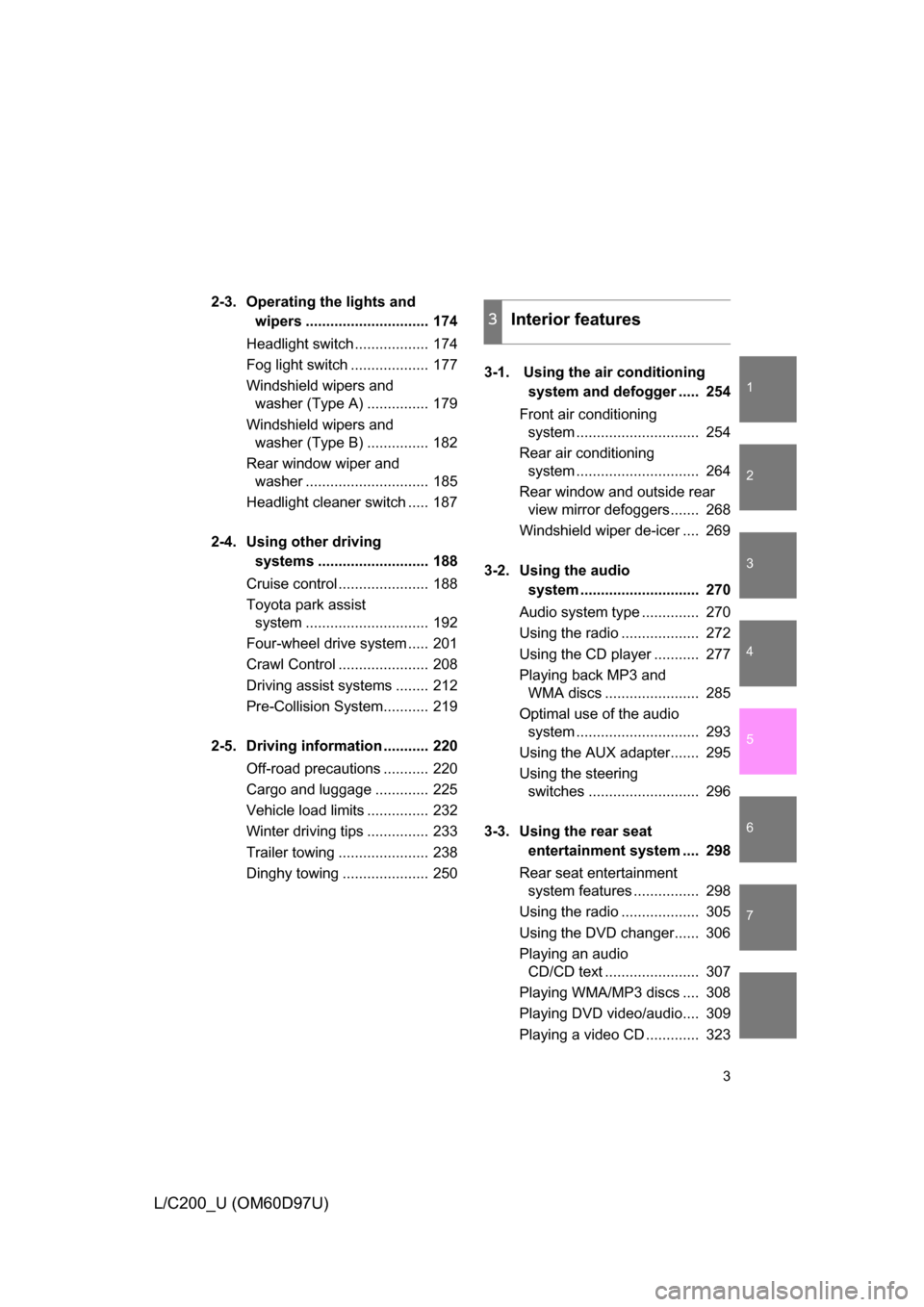
1
2
3
4
5
6
7
3
L/C200_U (OM60D97U)
2-3. Operating the lights and wipers .............................. 174
Headlight switch .................. 174
Fog light switch ................... 177
Windshield wipers and washer (Type A) ............... 179
Windshield wipers and washer (Type B) ............... 182
Rear window wiper and washer .............................. 185
Headlight cleaner switch ..... 187
2-4. Using other driving systems ........................... 188
Cruise control ...................... 188
Toyota park assist system .............................. 192
Four-wheel drive system ..... 201
Crawl Control ...................... 208
Driving assist systems ........ 212
Pre-Collision System........... 219
2-5. Driving information ........... 220 Off-road precautions ........... 220
Cargo and luggage ............. 225
Vehicle load limits ............... 232
Winter driving tips ............... 233
Trailer towing ...................... 238
Dinghy towing ..................... 250 3-1. Using the air conditioning
system and defogger ..... 254
Front air conditioning system .............................. 254
Rear air conditioning system .............................. 264
Rear window and outside rear view mirror defoggers....... 268
Windshield wiper de-icer .... 269
3-2. Using the audio system ............................. 270
Audio system type .............. 270
Using the radio ................... 272
Using the CD player ........... 277
Playing back MP3 and WMA discs ....................... 285
Optimal use of the audio system .............................. 293
Using the AUX adapter....... 295
Using the steering switches ........................... 296
3-3. Using the rear seat entertainment system .... 298
Rear seat entertainment system features ................ 298
Using the radio ................... 305
Using the DVD changer...... 306
Playing an audio CD/CD text ....................... 307
Playing WMA/MP3 discs .... 308
Playing DVD video/audio.... 309
Playing a video CD ............. 323
3Interior features
Page 141 of 556
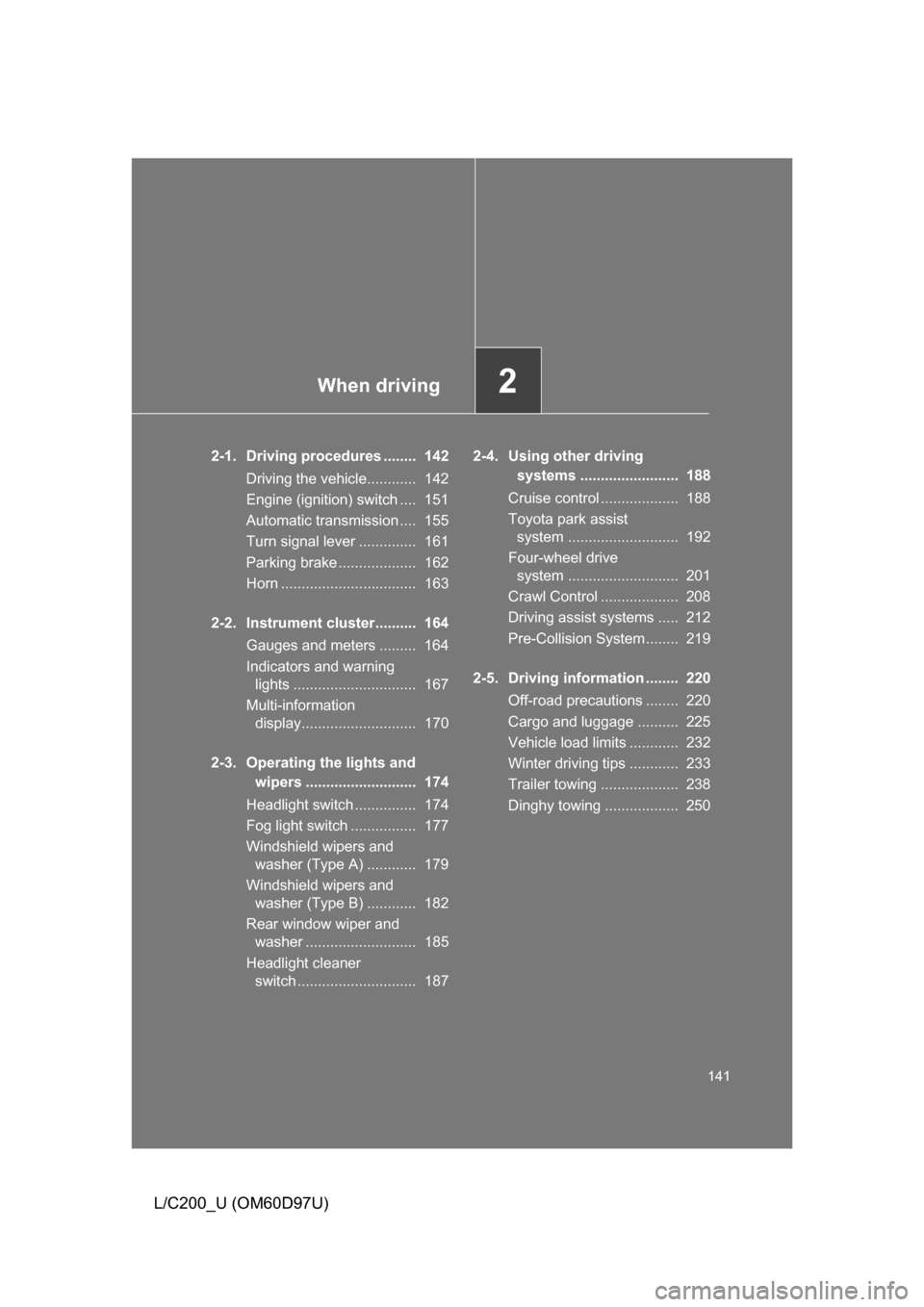
When driving2
141
L/C200_U (OM60D97U)
2-1. Driving procedures ........ 142Driving the vehicle............ 142
Engine (ignition) switch .... 151
Automatic transmission .... 155
Turn signal lever .............. 161
Parking brake ................... 162
Horn ................................. 163
2-2. Instrument cluster.......... 164 Gauges and meters ......... 164
Indicators and warning lights .............................. 167
Multi-information display............................ 170
2-3. Operating the lights and wipers ........................... 174
Headlight switch ............... 174
Fog light switch ................ 177
Windshield wipers and washer (Type A) ............ 179
Windshield wipers and washer (Type B) ............ 182
Rear window wiper and washer ........................... 185
Headlight cleaner switch ............................. 187 2-4. Using other driving
systems ........................ 188
Cruise control ................... 188
Toyota park assist system ........................... 192
Four-wheel drive system ........................... 201
Crawl Control ................... 208
Driving assist systems ..... 212
Pre-Collision System........ 219
2-5. Driving information ........ 220 Off-road precautions ........ 220
Cargo and luggage .......... 225
Vehicle load limits ............ 232
Winter driving tips ............ 233
Trailer towing ................... 238
Dinghy towing .................. 250
Page 143 of 556
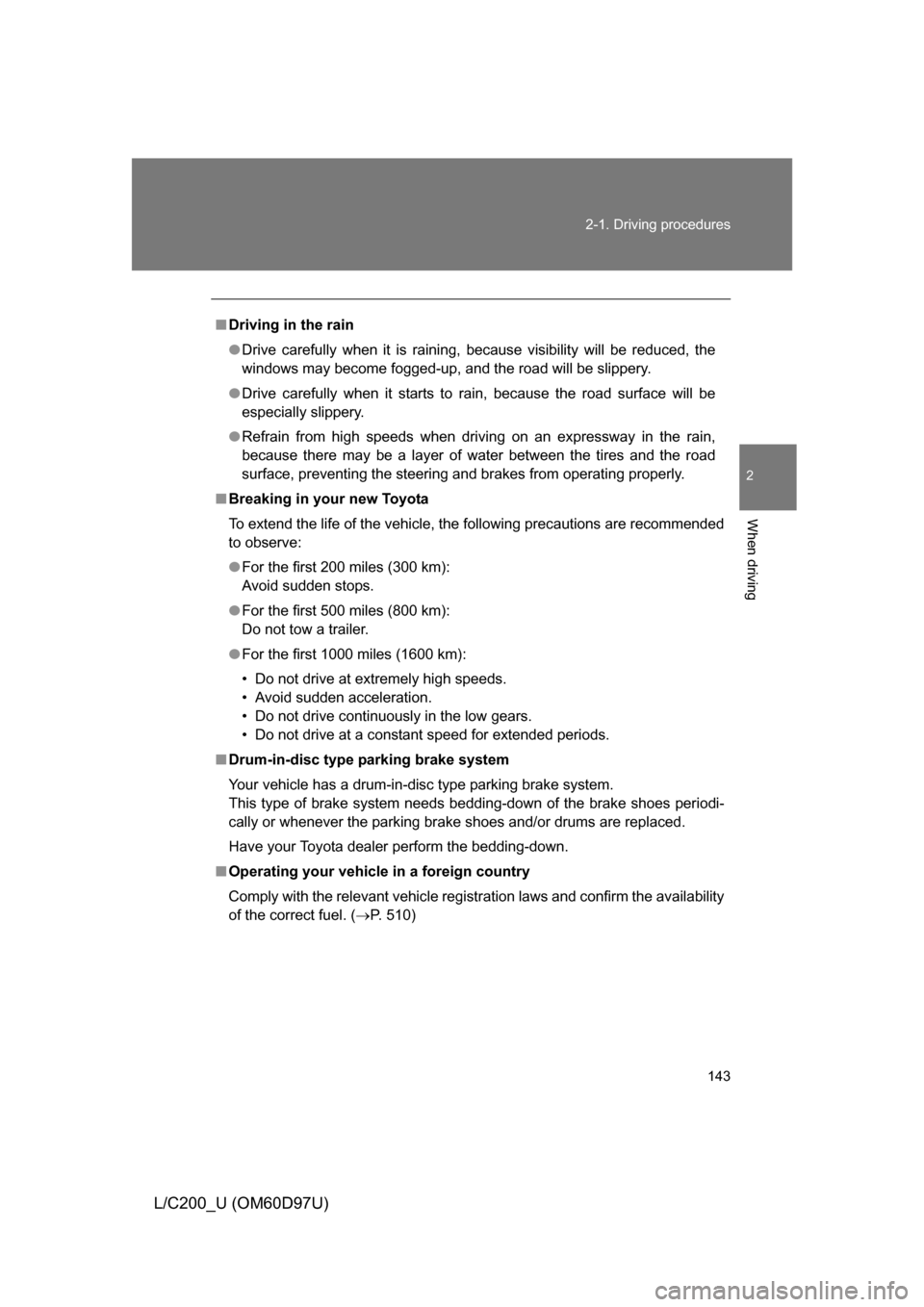
143
2-1. Driving procedures
2
When driving
L/C200_U (OM60D97U)
■
Driving in the rain
● Drive carefully when it is raining, because visibility will be reduced, the
windows may become fogged-up, and the road will be slippery.
● Drive carefully when it starts to rain, because the road surface will be
especially slippery.
● Refrain from high speeds when driving on an expressway in the rain,
because there may be a layer of water between the tires and the road
surface, preventing the steering and brakes from operating properly.
■ Breaking in your new Toyota
To extend the life of the vehicle, the following precautions are recommended
to observe:
● For the first 200 miles (300 km):
Avoid sudden stops.
● For the first 500 miles (800 km):
Do not tow a trailer.
● For the first 1000 miles (1600 km):
• Do not drive at extremely high speeds.
• Avoid sudden acceleration.
• Do not drive continuously in the low gears.
• Do not drive at a constant speed for extended periods.
■ Drum-in-disc type parking brake system
Your vehicle has a drum-in-disc type parking brake system.
This type of brake system needs bedding-down of the brake shoes periodi-
cally or whenever the parking brake shoes and/or drums are replaced.
Have your Toyota dealer perform the bedding-down.
■ Operating your vehicle in a foreign country
Comply with the relevant vehicle registration laws and confirm the availability
of the correct fuel. ( P. 510)
Page 227 of 556
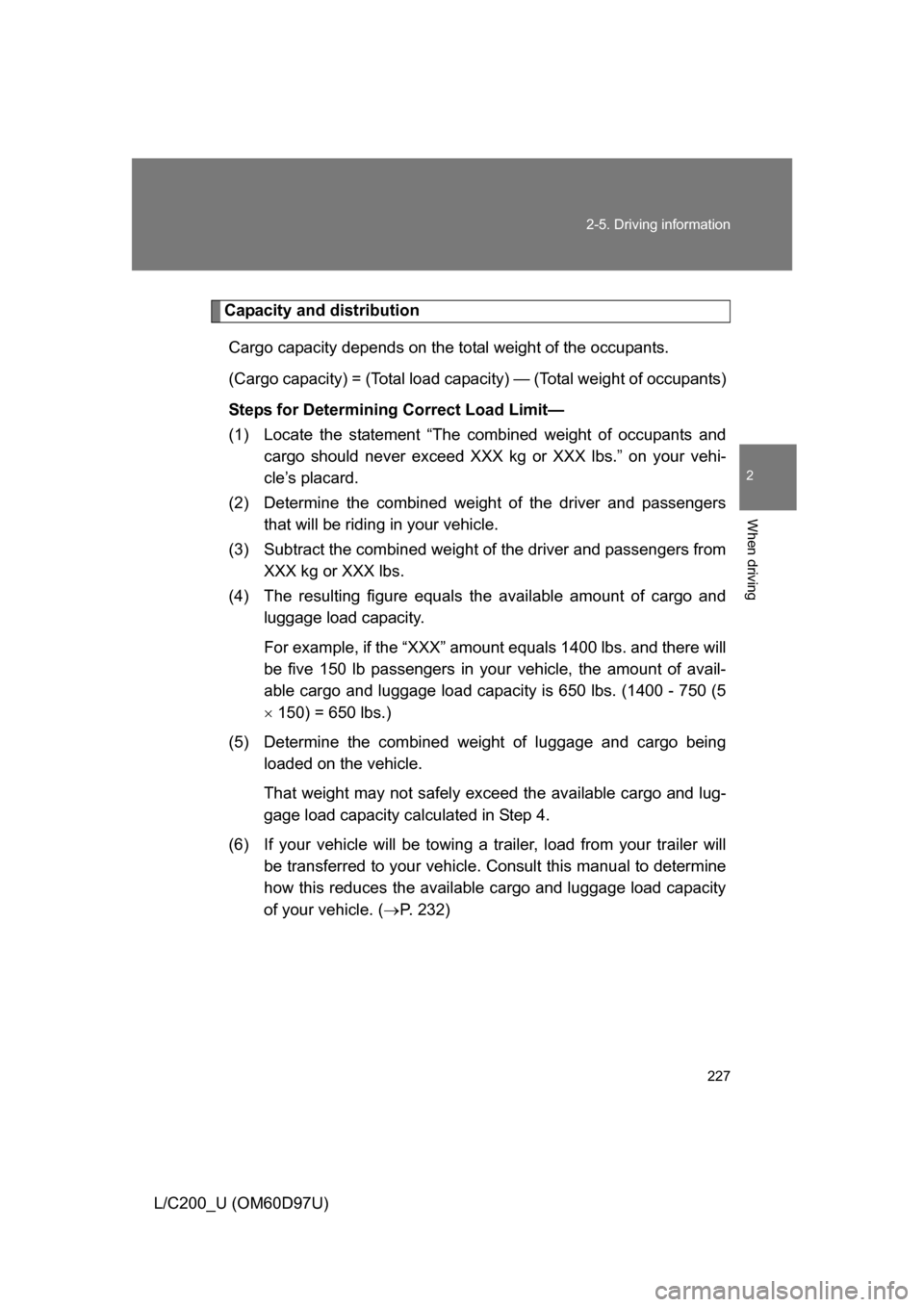
227
2-5. Driving information
2
When driving
L/C200_U (OM60D97U)
Capacity and distribution
Cargo capacity depends on the total weight of the occupants.
(Cargo capacity) = (Total load capa city) — (Total weight of occupants)
Steps for Determining Correct Load Limit—
(1) Locate the statement “The co mbined weight of occupants and
cargo should never exceed XXX kg or XXX lbs.” on your vehi-
cle’s placard.
(2) Determine the combined weight of the driver and passengers that will be riding in your vehicle.
(3) Subtract the combined weight of the driver and passengers from
XXX kg or XXX lbs.
(4) The resulting figure equals the available amount of cargo and luggage load capacity.
For example, if the “XXX” amount equals 1400 lbs. and there will
be five 150 lb passengers in your vehicle, the amount of avail-
able cargo and luggage load capacity is 650 lbs. (1400 - 750 (5
150) = 650 lbs.)
(5) Determine the combined weight of luggage and cargo being loaded on the vehicle.
That weight may not safely ex ceed the available cargo and lug-
gage load capacity calculated in Step 4.
(6) If your vehicle will be towing a tr ailer, load from your trailer will
be transferred to your vehicle. Consult this manual to determine
how this reduces the available cargo and luggage load capacity
of your vehicle. ( P. 232)
Page 232 of 556
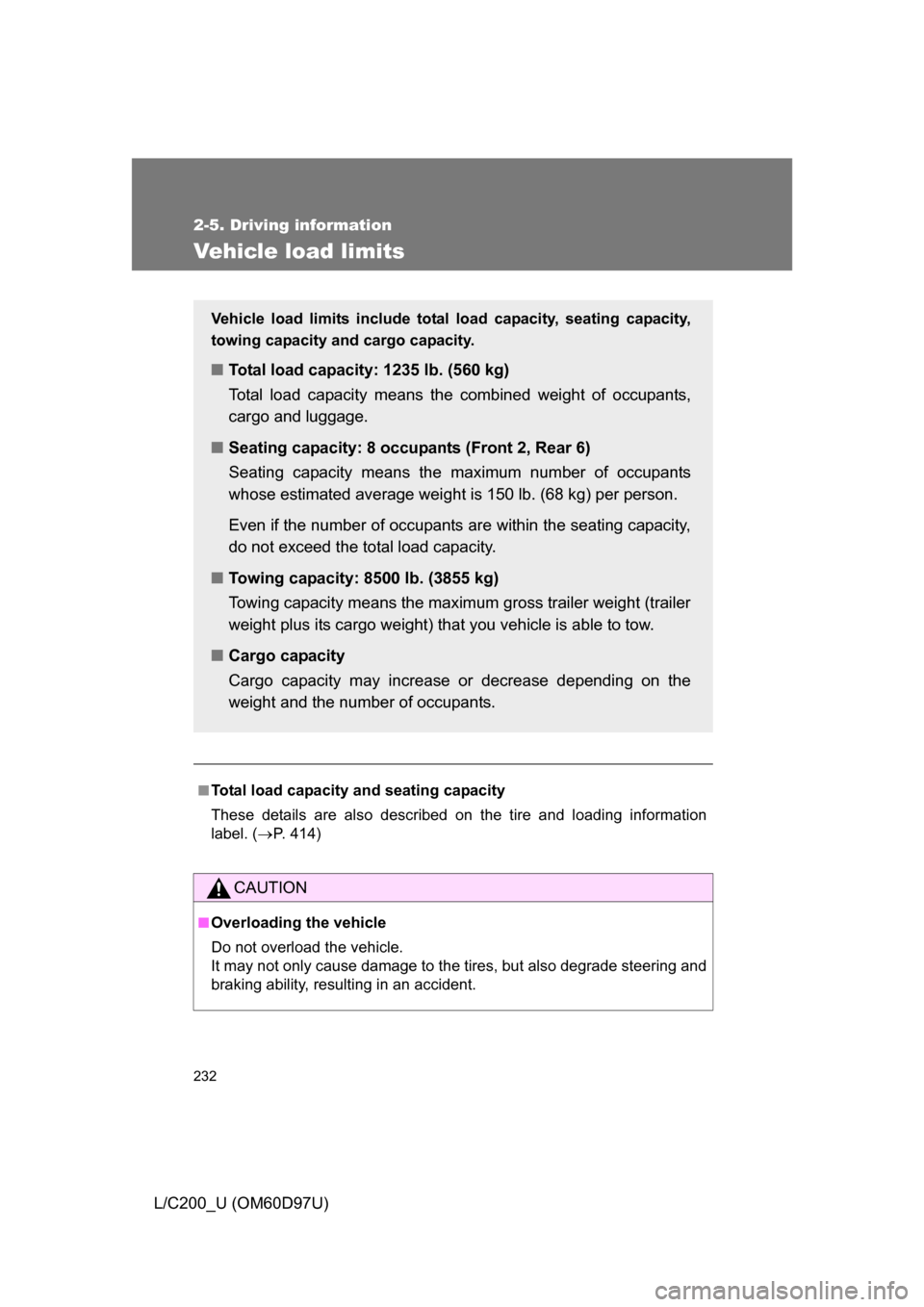
232
2-5. Driving information
L/C200_U (OM60D97U)
Vehicle load limits
■Total load capacity and seating capacity
These details are also described on the tire and loading information
label. (P. 414)
CAUTION
■Overloading the vehicle
Do not overload the vehicle.
It may not only cause damage to the ti res, but also degrade steering and
braking ability, resulting in an accident.
Vehicle load limits include total load capacity, seating capacity,
towing capacity and cargo capacity.
■ Total load capacity: 1235 lb. (560 kg)
Total load capacity means the combined weight of occupants,
cargo and luggage.
■ Seating capacity: 8 occupants (Front 2, Rear 6)
Seating capacity means the ma ximum number of occupants
whose estimated average weight is 150 lb. (68 kg) per person.
Even if the number of occupants are within the seating capacity,
do not exceed the total load capacity.
■ Towing capacity: 8500 lb. (3855 kg)
Towing capacity means the maximum gross trailer weight (trailer
weight plus its cargo weight) that you vehicle is able to tow.
■ Cargo capacity
Cargo capacity may increase or decrease depending on the
weight and the number of occupants.
Page 238 of 556
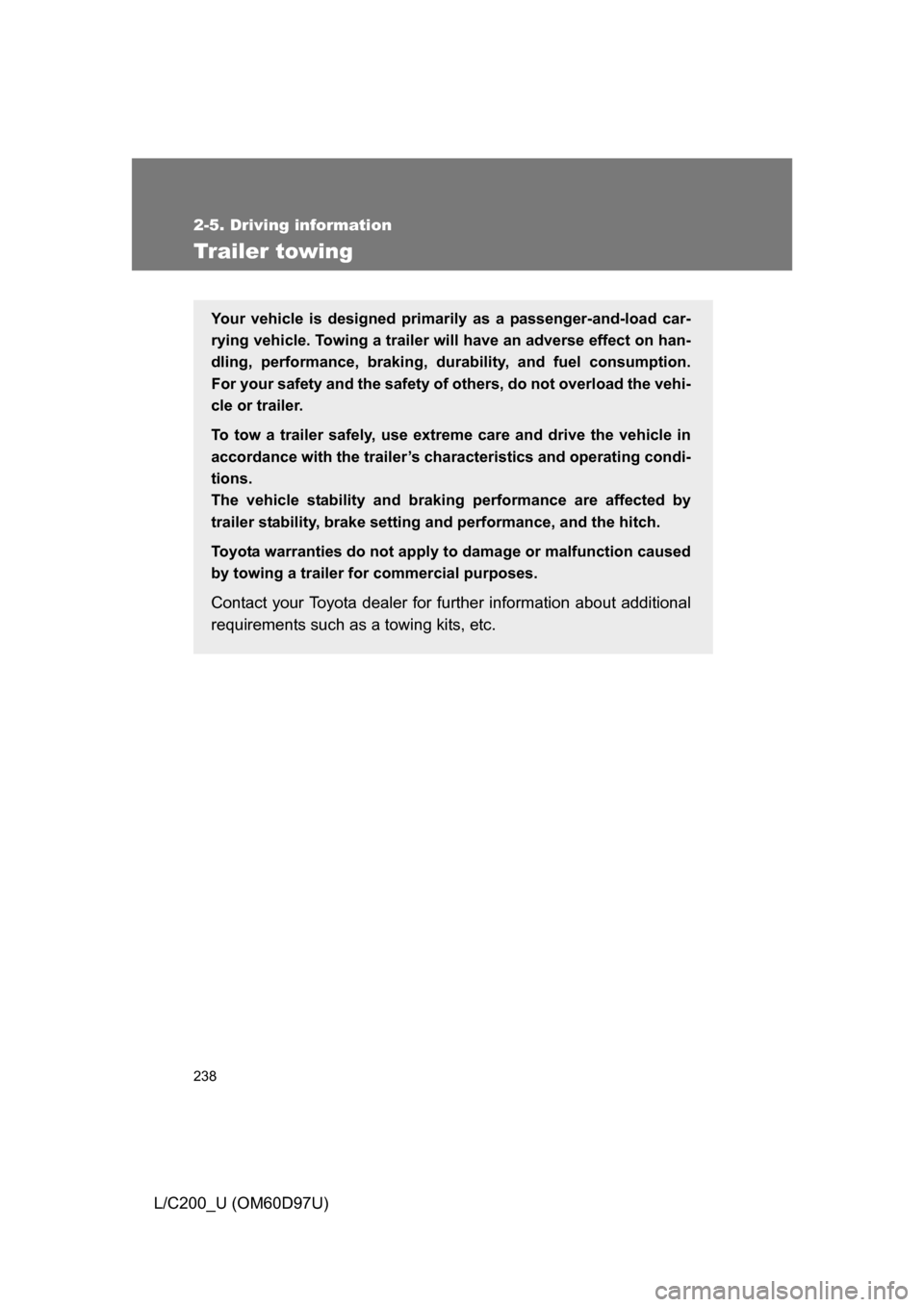
238
2-5. Driving information
L/C200_U (OM60D97U)
Trailer towing
Your vehicle is designed primarily as a passenger-and-load car-
rying vehicle. Towing a trailer will have an adverse effect on han-
dling, performance, braking, durability, and fuel consumption.
For your safety and the safety of others, do not overload the vehi-
cle or trailer.
To tow a trailer safely, use extreme care and drive the vehicle in
accordance with the trailer’s characteristics and operating condi-
tions.
The vehicle stability and braking performance are affected by
trailer stability, brake setting and performance, and the hitch.
Toyota warranties do not apply to damage or malfunction caused
by towing a trailer for commercial purposes.
Contact your Toyota dealer for further information about additional
requirements such as a towing kits, etc.
Page 239 of 556
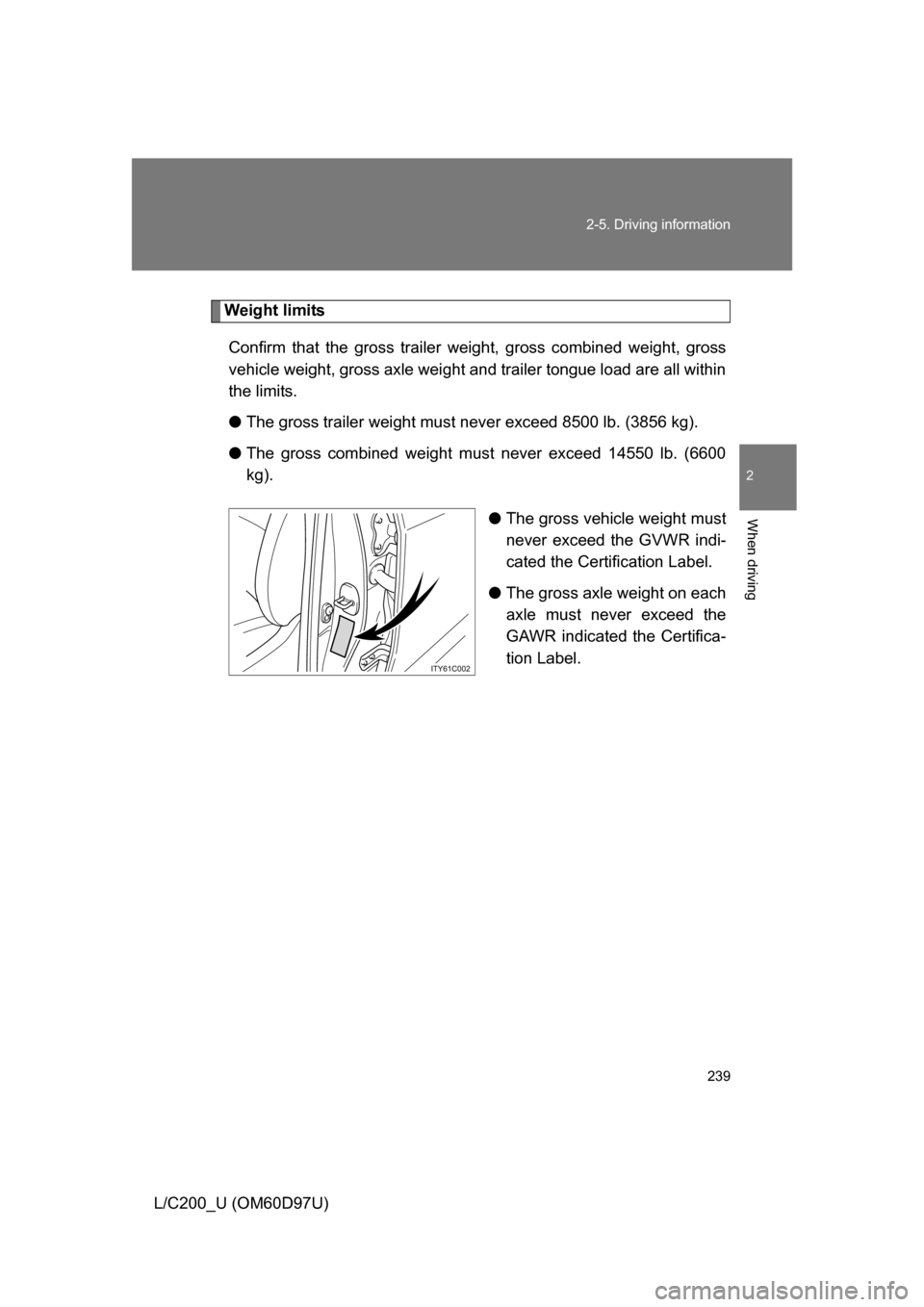
239
2-5. Driving information
2
When driving
L/C200_U (OM60D97U)
Weight limits
Confirm that the gross trailer weight, gross combined weight, gross
vehicle weight, gross axle weight and trailer tongue load are all within
the limits.
● The gross trailer weight must never exceed 8500 lb. (3856 kg).
● The gross combined weight must never exceed 14550 lb. (6600
kg).
●The gross vehicle weight must
never exceed the GVWR indi-
cated the Certification Label.
● The gross axle weight on each
axle must never exceed the
GAWR indicated the Certifica-
tion Label.
ITY61C002
Page 240 of 556
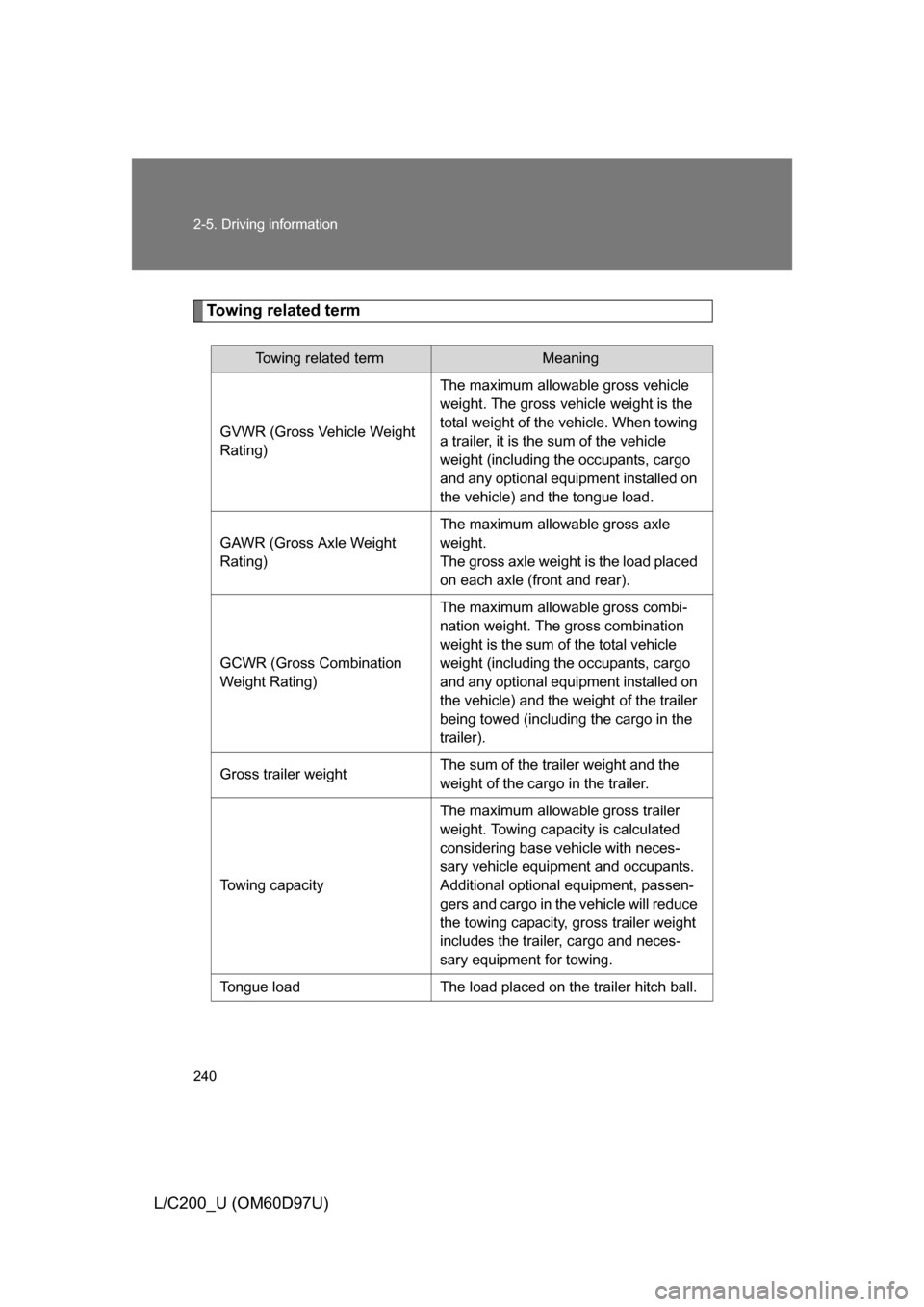
240 2-5. Driving information
L/C200_U (OM60D97U)
Towing related term
Towing related termMeaning
GVWR (Gross Vehicle Weight
Rating) The maximum allowable gross vehicle
weight. The gross vehicle weight is the
total weight of the vehicle. When towing
a trailer, it is the sum of the vehicle
weight (including the occupants, cargo
and any optional equipment installed on
the vehicle) and the tongue load.
GAWR (Gross Axle Weight
Rating) The maximum allowable gross axle
weight.
The gross axle weight is the load placed
on each axle (front and rear).
GCWR (Gross Combination
Weight Rating) The maximum allowable gross combi-
nation weight. The gross combination
weight is the sum of the total vehicle
weight (including the occupants, cargo
and any optional equipment installed on
the vehicle) and the weight of the trailer
being towed (including the cargo in the
trailer).
Gross trailer weight The sum of the trailer weight and the
weight of the cargo in the trailer.
Towing capacity The maximum allowable gross trailer
weight. Towing capacity is calculated
considering base vehicle with neces-
sary vehicle equipment and occupants.
Additional optional equipment, passen-
gers and cargo in the vehicle will reduce
the towing capacity, gross trailer weight
includes the trailer, cargo and neces-
sary equipment for towing.
Tongue load The load placed on the trailer hitch ball.